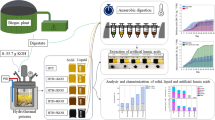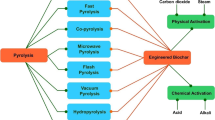Abstract
Urea-formaldehyde polymer is currently used as asorbent for containment and clean up of hydrocarbons. The aerobic biodegradability of this polymer andhydrocarbons sorbed to the polymer were tested. Soilmicroorganisms readily grew on the polymer, and twoorganisms, a bacterium and a fungus, capable of growthon the polymer were isolated. However, biodegradationof the polymer was very slow and possibly incomplete. Biodegradation of the polymer was evident as a changein appearance of the polymer, but disappearance of thepolymer was not detectable in liquid culturesincubated for six months or soil cultures incubatedfor one month. Destruction of the polymer by soilmicroorganisms at ambient temperature does not appearto be practical. Degradation of 14C-labeledhexadecane and phenanthrene mixed with crude oil inliquid cultures inoculated with soil microorganismswas used as an estimate of general hydrocarbondegradation. When nitrogen was not limiting, therates of hexadecane and phenanthrene degradation werethe same, whether those hydrocarbons were sorbed tothe polymer or not sorbed. When nitrogen waslimiting, the polymer stimulated the rate ofhexadecane degradation but not the rate ofphenanthrene degradation. The polymer may stimulatehexadecane degradation by serving as a source ofnitrogen. However, optimal degradation of sorbedhydrocarbons requires nitrogen addition. The resultssuggest that it may be feasible to decontaminate spentpolymer by biodegradation of sorbed hydrocarbons.
Similar content being viewed by others
References
Alexander M(1994) Biodegradation and Bioremediation. Academic Press, San Diego
Fogel S, Lancione R, Sewall A & Boethling RS (1985) Application of biodegradability screening tests to insoluble chemicals: hexadecane. Chemosphere 14: 375–382
Guerin WF & Boyd SA (1992) Differential bioavailability of soilsorbed naphthalene to two bacterial species. Appl. Environ. Microbiol. 58: 1142–1152
Mihelcic JR & Luthy RG (1988) Degradation of polycyclic aromatic hydrocarbon compounds under various redox conditions in soilwater systems. Appl. Environ. Microbiol. 54: 1182–1187
Mohn WW(1995) Bacteria obtained from a sequencing batch reactor that are capable of growth on dehydroabietic acid. Appl. Environ. Microbiol. 61: 2145–2150
Mouche C (1995) Managing used oil. Pollution Engineering 27: 40–43
Nakahara T, Erickson LE & Gutierrez JR (1977) Characteristics of hydrocarbon uptake in cultures with two liquid phases. Biotechnol. Bioeng. 19: 9–25
Shelton DR & Tiedje JM (1984) General method for determining anaerobic biodegradation potential. Appl. Environ. Microbiol. 47: 850–857
Singer ME & Finnerty WR (1984) Microbial metabolism of straightchain and branched alkanes. In: Atlas RM(Ed) Petroleum Microbiology (pp 1–60). Macmillan Publishing Co., New York
Stucki G & Alexander M (1987) Role of dissolution rate and solubility in biodegradation of aromatic compounds. Appl. Environ. Microbiol. 53: 292–297
Subba-Rao RV & Alexander M (1982) Effect of sorption on mineralization of low concentrations of aromatic compounds in lake water samples. Appl. Environ. Microbiol. 44: 659–668
Thomas JM, Yordy JR, Amador JA & Alexander M (1986) Rates of dissolution and biodegradation of water-insoluble organic compounds. Appl. Environ. Microbiol. 52: 290–296
Tsomides HJ, Hughes JB, Thomas JM & Ward CH (1995) Effect of surfactant addition on phenanthrene biodegradation in sediments. Environ. Toxicol. Chem. 14: 953–959
Wang DIC & Ochoa A (1972) Measurements on the interfacial areas of hydrocarbon in yeast fermentations and relationships of specific growth rates. Biotechnol. Bioeng. 14: 345–360
Wodzinski RS & Bertolini D (1972) Physical state in which naphthalene and biphenyl are utilized by bacteria. Appl. Microbiol. 23: 1077–1081
Wodzinski RS & Coyle JE (1974) Physical state of phenanthrene for utilization by bacteria. Appl. Microbiol. 27: 1081–1084
Author information
Authors and Affiliations
Rights and permissions
About this article
Cite this article
Mohn, W.W. Indirect bioremediation: biodegradation of hydrocarbons on a commercial sorbent. Biodegradation 8, 15–19 (1997). https://doi.org/10.1023/A:1008285705628
Issue Date:
DOI: https://doi.org/10.1023/A:1008285705628




